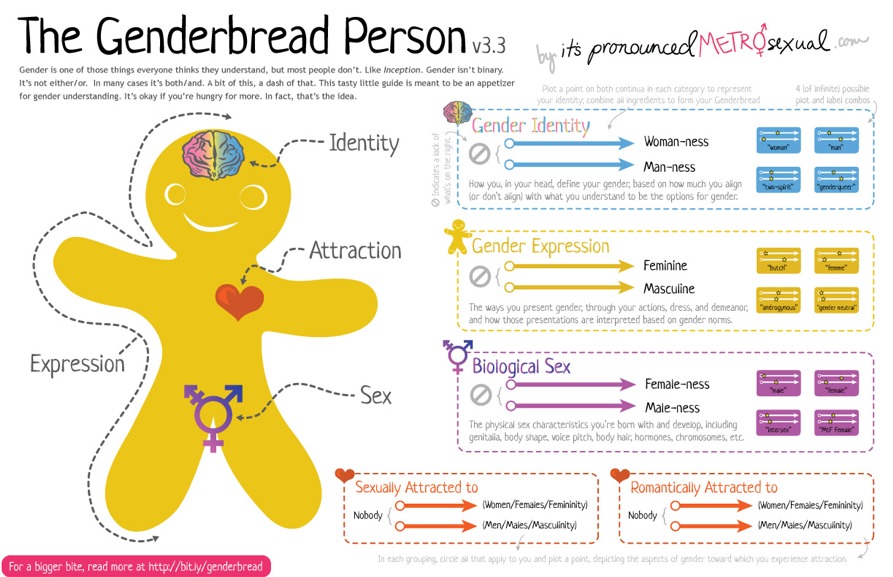LGBTQ+ Glossary Guide
You’ve probably heard of the terms ‘LGBTQ+’ used before, but understanding what it means can be confusing. Here’s a handy guide to help aid your understanding.
What LGBTQ+ means:
- Lesbian: A lesbian woman is someone who is romantically, emotionally and/or sexually attracted to women.
- Gay: A gay man is someone who is romantically, emotionally and/or sexually attracted to men. Gay can also be used as an umbrella term for all the orientations and identities on the LGBT+ spectrum.
- Bisexual: A bisexual person is someone who is romantically, emotionally and/or sexually attracted to males and females.
- Transgender (Trans): Transgender is an umbrella term used to describe someone who’s gender expression and/or gender identity differs from the gender that they were assigned at birth. It is important to note that not everyone whose appearance is gender-atypical will identify as transgender.
- Queer/ Questioning : Queer traditionally meant strange or weird, which was then used to describe those who were LGBTQ+ in the 19th century. It has since been reclaimed by some of the LGBTQ+ community as an umbrella term for those who are not heterosexual and/or cisgender. Q also stands for questioning, representing those who may be unsure of their sexual orientation and/or gender identity.
- + (Plus): The plus in LGBTQ+ is used to signify all of the sexual orientations and gender identities that are not specified in the other five letters.
Types of Attraction:
The Asexual Visibility and Education Network (AVEN) have explored a range of different types of ways that people are attracted to each other, beyond the most commonly known type which is sexually. The main types they have identified are:
- Sexual: The desire to engage in sex with someone.
- Romantic: The desire to be romantically connected with someone (more articles to come on this).
- Sensual: The desire to engage in sensual activities with someone, this can range from things like cuddling, holding hands, giving or receiving massages, etc.
- Aesthetic: This is usually an emotional response to seeing something that you consider beautiful or visually appealing.
These attractions form orientations that make up part of your identity and can be used to explain how you experience attraction to others. The identities do not need to all align with each other, though many people experience it that way, but it is perfectly normal and okay if you don’t.
Sexual Orientation:
Sexual orientation is a way to explain your sexual attraction to others and it comes with a variety of different identities that explain that. Here are some of the common ones:
- Heterosexual/straight: The sexual attraction to people of the different sex.
- Homosexual/gay/lesbian: The sexual attraction to people of the same sex.
- Bisexual: The sexual attraction to people of two different sexes (more can be read about this under Sexual and Gender Identity).
- Asexual: The lack of sexual attraction to people.
Some less common sexual orientations include:
- Androsexual: The attraction to men.
- Gynosexual: The attraction to women.
- Skoliosexual: The attraction to people who are non-binary (i.e. to someone who doesn’t define themselves as male or female, or a man or a woman – see Sexual and Gender Identity below).
- Demisexual: The attraction to people based on an emotional connection (an article will be posted soon).
Romantic Orientation:
Romantic orientations are like sexual orientations in that they explain how you experience romantic attraction to people. They use the same set of prefixes as sexual orientation, like hetero- and homo-, but use the suffix of romantic instead, such as:
- Heteroromantic: The romantic attraction to people of the different sex.
- Homoromantic: The romantic attraction to people of the same sex.
- Aromantic: The lack of romantic attraction to people.
Sensual and Aesthetic Orientations:
Like the other orientations, they use the prefixes mentioned above, but they use the -sensual suffix for sensual attractions and -aesthetic suffix for aesthetic attractions.
Sex:
A person’s sex is a biological description of the person’s biology. Sex is made up of:
- Sexual organs, such as the penis and vagina
- Chromosomes, such as XY or XX
- Hormones, such as testosterone and estrogen
Medically, there are currently two officially-recognised sexes in the UK: male and female, however, there are currently debates over the inclusion to recognise a third sex known as intersex.
Gender:
Gender is the attitudes, feelings, and behaviours that a different cultures associate with a person’s biological sex.
Gender Identity:
Gender identity is one’s own self-definition of gender and how that person experiences it. There are many different gender identities, but some of the most recognised are:
- Male
- Female
- Bi-Gender
- Genderfluid/non-binary
Gender Expression:
Gender Expression is the way a person chooses to present their gender identity through interests, clothes, body language and many other forms of expression. This is usually taken from societal concepts, such as “girls wear pink” and “guys wear blue”, but, as always, this changes over time, as it once was considered to be the other way around.
Trans* Terminology:
Trans* is an umbrella term for used for many of the identities below:
- Assigned gender: This is the gender (typically male or female) that is given to a baby at birth, usually based on their perceived sex.
- Transgender: This is an adjective that describes the fact that the person self-defines as a gender identity that differs from the one assigned gender at birth.
- Transsexual: This is an adjective that describes the fact the person has physically changed their sexual status in some way (usually through hormones or surgically).
- Cisgender: A term to describe that a person’s gender identity matches that of the one they were assigned at birth.
- Cissexual: A term used to describe that the person’s sex has not changed from the one they were classified as at birth.
Genderbread person – A Useful Infographic:

Source: It’s Pronounced Metrosexual
For more definitions, please look at Stonewall’s Glossary of Terms

Funding Partners


